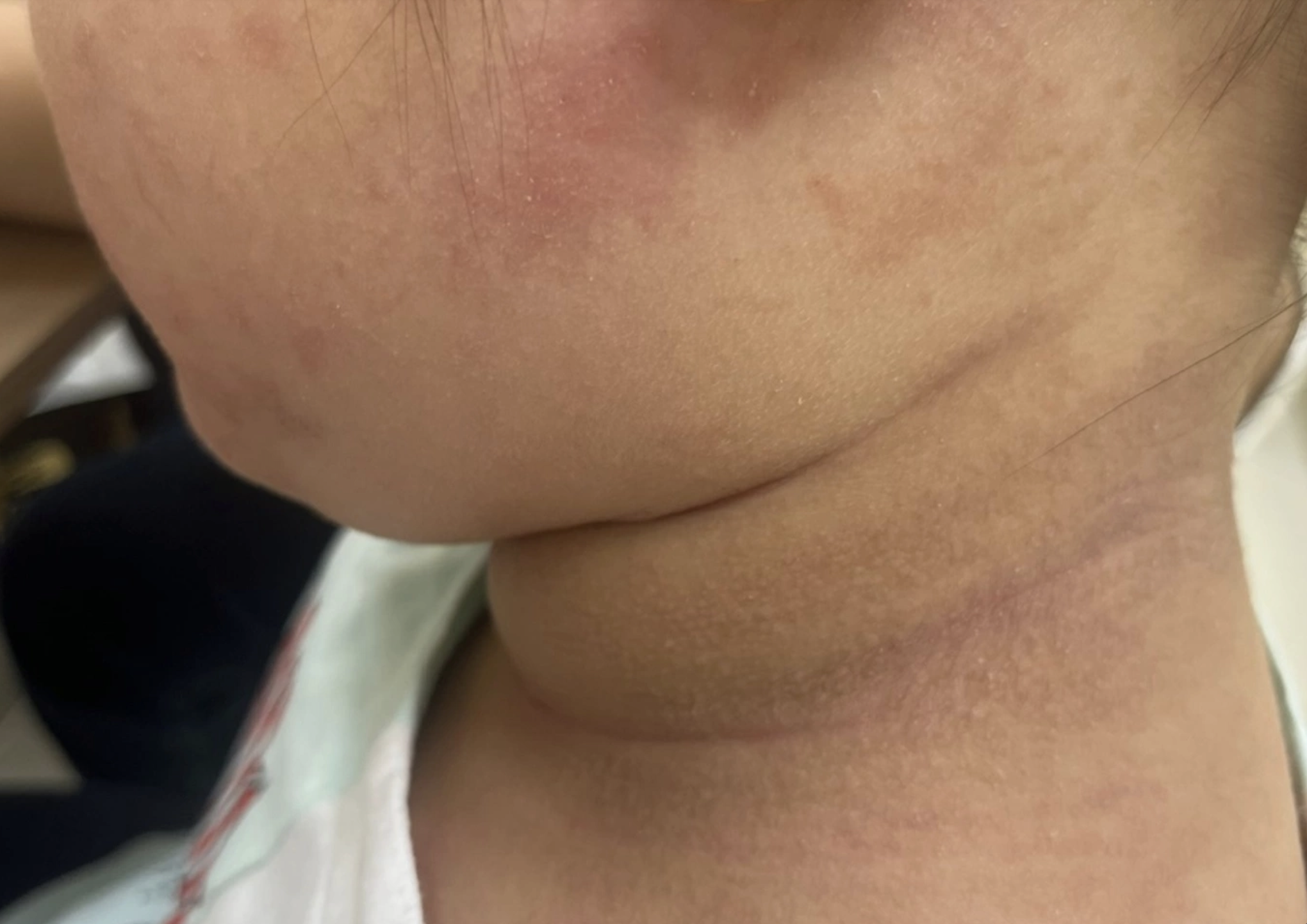Doctor Quach Thu Trang, Department of Dermatology, Tam Anh General Hospital, Hanoi, explains that children's immune systems and sweat glands are not yet fully developed, and their skin is more sensitive than adults'. This makes them susceptible to bacterial growth and outbreaks, especially during hot, humid, rainy, and fluctuating weather. Improper hygiene or reactions to sunlight are other factors that increase the risk of skin conditions in children. Common symptoms include redness, itching, swelling, blisters, and changes in skin color, depending on the severity. Here are 4 of the most common skin conditions.
Heat rash
Heat rash is the most common skin condition in young children because their sweat glands are not fully developed. Their pores can easily become blocked when the body sweats a lot, especially on the back, neck, and forehead. A child's skin is thin and sensitive, making it prone to irritation and inflammation of the sweat glands.
Heat rash spots are usually small and red, and may be accompanied by blisters that cause itching, discomfort, fussiness, and scratching. This scratching can easily lead to skin abrasions and infections. Parents should bathe their children with clean water every day, using a mild baby wash and avoiding regular soap. Dress children in loose, absorbent clothing and ensure a cool, well-ventilated environment.
Impetigo
Impetigo is a bacterial skin infection caused by streptococcus or staphylococcus, which is easily spread through direct contact or sharing personal items. If not treated promptly, the infection can spread, causing eczema, sepsis, or acute glomerulonephritis.
Doctor Trang explains that impetigo usually appears around the nose, mouth, hands, and feet, and has two forms: bullous and non-bullous. Bullous impetigo begins with shallow, easily ruptured blisters filled with clear fluid, which later turns dark yellow, leaving a moist, red area. Non-bullous impetigo typically presents as small blisters or pustules that quickly rupture, forming honey-colored crusts, and may also leave a moist, red base.
If a child shows signs of impetigo, wash the affected area thoroughly, apply medication as prescribed, cover the sores, wash the child's clothes and towels separately, and trim their nails to prevent scratching and spreading the infection.
Ringworm
Ringworm often appears in damp areas and skin folds, such as between fingers and toes, in the groin, and on the buttocks. Children who wear tight clothing, have poor hygiene, or come into contact with infected pets are at higher risk. Common signs include circular or arc-shaped red patches with a defined border, itching, scaling, and possibly small blisters. Ringworm on the scalp can cause patchy hair loss, accompanied by redness or pus.
According to Doctor Trang, treatment includes topical antifungal medication for 2-4 weeks. Ringworm of the scalp often requires oral medication and longer treatment. Parents should not apply corticosteroids without a doctor's advice, as this can cause the fungus to spread and become difficult to control.
 |
The neck, with its folds, is a common area for children to develop skin irritation. Photo: *Tam Anh General Hospital* |
Sun-related skin conditions
Phytophotodermatitis is an inflammatory skin reaction that occurs after exposure to sunlight in combination with cosmetics, medications, or certain plants. Sunburns from prolonged sun exposure can cause redness, pain, blistering, or peeling skin. UV rays can also cause skin pigmentation disorders, leading to brown spots, freckles (hyperpigmentation), or light patches (hypopigmentation). Typical symptoms include redness, itching, swelling, blistering, and changes in skin color.
To prevent sun-related skin conditions, parents should limit children's outdoor activities between 10 a.m. and 4 p.m., when UV rays are strongest. When outdoors, children should wear long-sleeved shirts, wide-brimmed hats, sunglasses, and sunscreen with an SPF of 30 or higher, applied 20-30 minutes before going outside and reapplied every two hours during continued outdoor activities. Children should play in shaded areas and avoid direct sunlight. After sun exposure, moisturize their skin and discourage scratching of red or irritated areas.
Doctor Trang advises parents to maintain a proper daily skincare routine for their children to prevent skin conditions. Bathe them regularly, dry skin folds thoroughly, dress them in loose, absorbent clothing, and change clothes immediately if they get wet. Never share towels, combs, or other personal items. Toys, bedding, and towels should be washed frequently. Trim children's nails regularly to prevent scratching and skin irritation. Limit contact with pets if a skin condition is suspected. If any unusual skin changes appear, take the child to a dermatologist for diagnosis and prompt treatment.
Hang Tran
| Readers can submit questions about skin diseases here for doctors to answer. |












